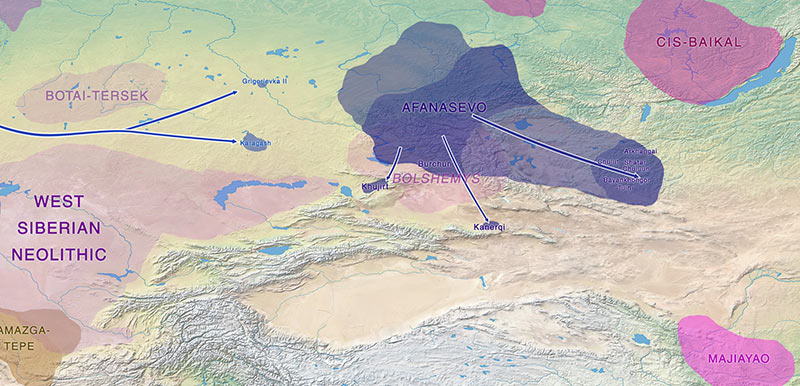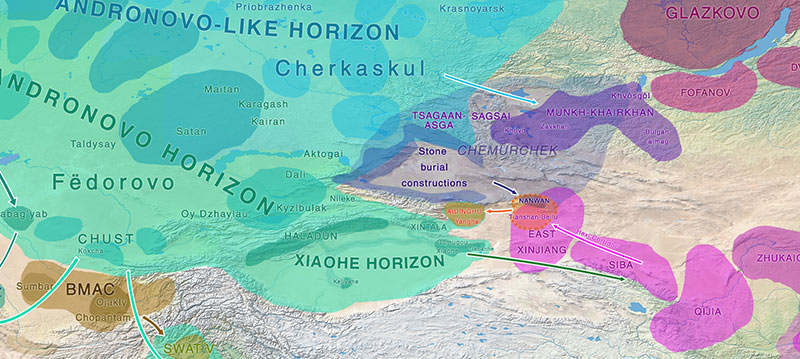-
-
Notifications
You must be signed in to change notification settings - Fork 3
Afanasievo
Afanasievo were an early (3300BC) bridge culture to china .
Afanasevans were descended from people who migrated c. 3700–3300 BCE across the Eurasian Steppe from the pre-Yamnaya Repin culture of the Don-Volga region.
Afanasevo is confirmed to be dominated by R1b-M269. Sintashta shows a mixed R1b-L23/ R1a-Z645 society
Afanasievo were "genetically indistinguishable" from the Yamnaya culture. the expansion of the ancestors of the Afanasievo people into the Altai was carried out through "large-scale migrations and population displacements",[1] without admixture with local populations. the study underpinned the theory that the Afansievo people were Indo-Europeans, perhaps ancestors of the Tocharians.
Both sampled Chemurchek individuals are of haplogroup R1b1a1a2a2-Z2103, in line with their almost direct genetic continuity with Afanasievo and with the two other reported samples to date (one C, one R1b).
Afanasievo shows local admixture
A striking finding in light of previous archaeological and genetic data is that the male child from Kurgak govi (individual I13957, skeletal code AT_629) has no evidence of Yamnaya-related ancestry despite his association with Afanasievo material culture (for example, he was buried in a barrow in the form of circular platform edged by vertical stone slabs, in stretched position on the back on the bottom of deep rectangular pit and with a typical Afanasievo egg-shaped vessel; his late Afanasievo chronology is confirmed by a direct radiocarbon date of 2858-2505 BCE). This is the first known case of an individual buried with Afanasievo cultural traditions who is not overwhelmingly Yamnaya-related
Breaking the lineage
https://indo-european.eu/2020/03/yamnaya-like-chemurchek-links-afanasievo-with-iron-age-tocharians/
While the Afanasievo-derived lineages are consistent with having largely disappeared in Mongolia by the Late Bronze Age when our data showed that later groups with Steppe pastoralist ancestry made an impact, we confirm and strengthen previous ancient DNA analysis suggesting that the legacy of this expansion persisted in western China into the Iron Age Shirenzigou culture (410-190 BCE): Afanasievo ancestry without the characteristic European farmer-related mixture, which appeared later in Central Asia and Mongolia, persisted in Xinjiang.
While there are mongolian cultures connecting Europe and China, genetically and geographically it is a long long distance between these two divergent lineages:
If anything we can hope that in the future genetic samples of pre-ice age individuals show that the apparent bridge was a was absent in pre-neolithic times, proving that indeed the Afanasievo generated this cline between Europe and China; and through extension: contributed to the formation of the chinese civilization not just culturally but also genetically.
Home | Alphabet | Grammar | Gardiner-signs
Home
preserved words
PIE
Inventions
Kur
Signs
Keyboard
Dictionary
Swadesh lists
Text Corpus
Axioms
Grammar
Pronouns
Numbers
Highlights
Cosmos
Gothic
Akkadian
determinatives
+
| äЯ | 𓄿 |
|---|---|
| A | 𓂝 |
| b | 𓃀 |
| c | 𓍿 |
| D | 𓏏 |
| δ | 𓂧 |
| E | 𓇋 |
| F | 𓇋𓆑 |
| G | 𓎼𓐍 |
| h | 𓉔 |
| I | 𓇋 |
| J | 𓆓 |
| K | 𓎡𓌨𓐍 |
| L | 𓏯𓃭 |
| M | 𓅓 |
| N | 𓈖 |
| ϱ | 𓍢𓍯 |
| P | 𓊪 |
| Q | 𓏘 |
| R | 𓂋 |
| S | 𓋴 |
| T | 𓏏 𓎀 |
| ṳ | 𓅱𓍢 |
| V | 𓆑 |
| W | 𓅳 |
| X | 𓎛 |
| Y | 𓏭 |
| Z | 𓊃 𓎀 |
| SH | 𓈙 |

